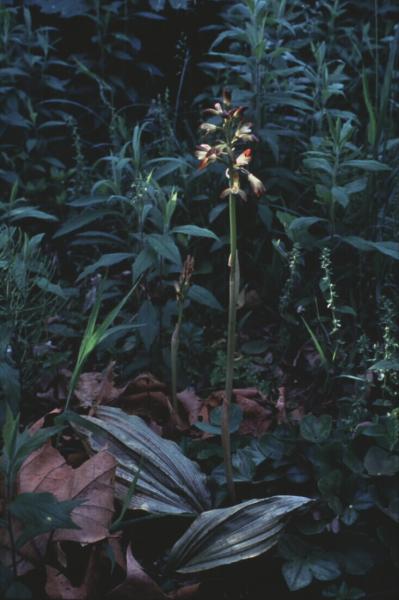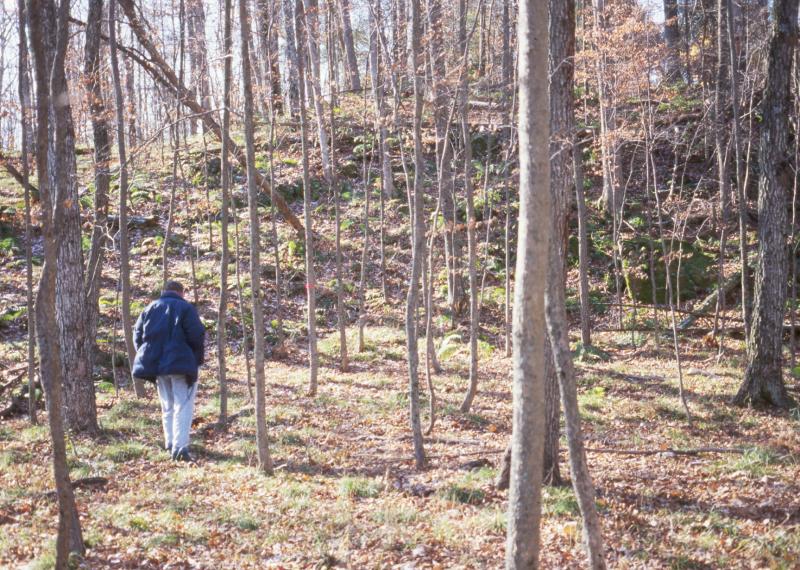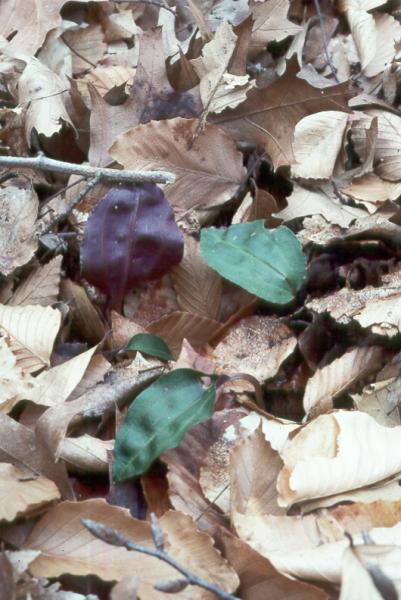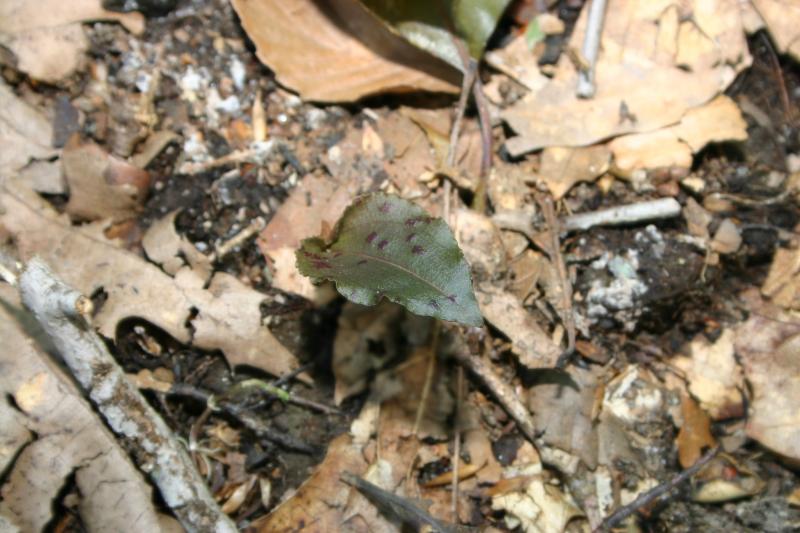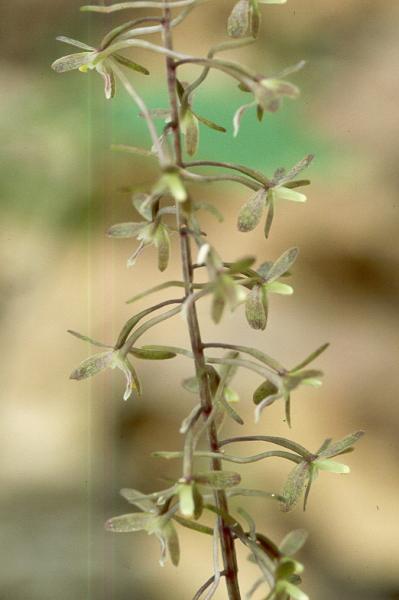Puttyroot
Aplectrum hyemale (Muhl. ex Willd.) Torr.
- Class
- Monocotyledoneae (Monocots)
- Family
- Orchidaceae (Orchid Family)
- State Protection
- Endangered
Listed as Endangered by New York State: in imminent danger of extirpation in New York. For animals, taking, importation, transportation, or possession is prohibited, except under license or permit. For plants, removal or damage without the consent of the landowner is prohibited.
- Federal Protection
- Not Listed
- State Conservation Status Rank
- S1
Critically Imperiled in New York - Especially vulnerable to disappearing from New York due to extreme rarity or other factors; typically 5 or fewer populations or locations in New York, very few individuals, very restricted range, very few remaining acres (or miles of stream), and/or very steep declines.
- Global Conservation Status Rank
- G5
Secure globally - Common in the world; widespread and abundant (but may be rare in some parts of its range).
Summary
Did you know?
The common name Adam-and-Eve orchid comes from the fact that old roots (Adam) give rise to new roots (Eve). The common name puttyroot is based on the historical use of the sticky substance found in the roots as a glue to mend pottery. You could say that this plant is a precursor to super glue.
State Ranking Justification
While this plant was apparently more common in the 1800s, today only three locations are known. This plant may face various threats, but the reasons for its decline are not well understood. There appears to be plenty of habitat available across a rather large portion of the state. While it seems unlikely that people would overlook an orchid, this is possible since the leaves are only visible from fall to spring.
Short-term Trends
Since 1950, only three populations have been observed and today only three still exist. These three populations have about 20-30 plants. While two populations are within protected landscapes, the trends might indicate broader threats that may one day lead to the loss of this plant from the New York flora.
Long-term Trends
Between 1850 and 1900 there were a minimum of 40 known populations. Between 1900 and 1950, the number of reported populations dropped to approximately 15. Since 1950, only three populations have been reported. The causes of this decline are unknown.
Conservation and Management
Threats
There are probably many influences that have lead to the sharp decline of this plant. These threats may include acid rain deposition, changes in soil chemistry, changes in the composition of soil fungal species, and deer herbivory.
Conservation Strategies and Management Practices
Provide a large undisturbed buffer around occurrences of this orchid. Monitor population numbers.
Research Needs
Research is needed to find the causes of the rapid decline of this species in the state.
Habitat
Habitat
This is an orchid of rich woods, often found near limestone outcrops or in calcareous talus. The moisture of the soil varies from mesic upland sites to damp low ground areas. Most of the woods are deciduous or mixed deciduous-evergreen (New York Natural Heritage Program 2005). Moist, deciduous, upland to swampy forests (Flora of North America 2002). Rare in moist, rich wooded slopes and bottomlands (Rhoads and Block 2000). Rich woods (Gleason & Cronquist 1991). Rich woods, both upland beech-maple and more swampy woods in low ground (Voss 1972). Rich woods (Fernald 1970).
Associated Ecological Communities
- Appalachian oak-hickory forest
(guide)
A hardwood forest that occurs on well-drained sites, usually on ridgetops, upper slopes, or south- and west-facing slopes. The soils are usually loams or sandy loams. This is a broadly defined forest community with several regional and edaphic variants. The dominant trees include red oak, white oak, and/or black oak. Mixed with the oaks, usually at lower densities, are pignut, shagbark, and/or sweet pignut hickory.
- Beech-maple mesic forest*
(guide)
A hardwood forest with sugar maple and American beech codominant. This is a broadly defined community type with several variants. These forests occur on moist, well-drained, usually acid soils. Common associates are yellow birch, white ash, hop hornbeam, and red maple.
- Calcareous talus slope woodland*
(guide)
An open or closed canopy community that occurs on talus slopes composed of calcareous bedrock such as limestone or dolomite. The soils are usually moist and loamy; there may be numerous rock outcrops.
- Limestone woodland
(guide)
A woodland that occurs on shallow soils over limestone bedrock in non-alvar settings, and usually includes numerous rock outcrops. There are usually several codominant trees, although one species may become dominant in any one stand.
- Maple-basswood rich mesic forest*
(guide)
A species rich hardwood forest that typically occurs on well-drained, moist soils of circumneutral pH. Rich herbs are predominant in the ground layer and are usually correlated with calcareous bedrock, although bedrock does not have to be exposed. The dominant trees are sugar maple, basswood, and white ash.
- Rich mesophytic forest*
(guide)
A hardwood or mixed forest that resembles the mixed mesophytic forests of the Allegheny Plateau south of New York but is less diverse. It occurs on rich, fine-textured, well-drained soils that are favorable for the dominance of a wide variety of tree species. A canopy with a relatively large number of codominant trees characterizes this forest. Canopy codominants include five or more of the following species: red oak, red maple, white ash, American beech, sugar maple, black cherry, cucumber tree, and black birch.
* probable association but not confirmed.
Associated Species
- Acer saccharum (sugar maple)
- Adlumia fungosa (Allegheny-vine)
- Brachyelytrum erectum (southern shorthusk)
- Carex albursina (white bear sedge)
- Carya cordiformis (bitternut hickory)
- Dryopteris marginalis (marginal wood fern)
- Fraxinus americana (white ash)
- Hepatica nobilis var. obtusa
- Ostrya virginiana (hop hornbeam, ironwood)
- Quercus mühlenbergii
- Quercus rubra (northern red oak)
- Solidago bicolor (silver-rod)
- Solidago caesia
- Tilia americana var. americana (American basswood)
Range
New York State Distribution
Historically this orchid has been reported throughout the state, but today it is only known from three population from the Adirondack Foothills, Eastern Allegheny Plateau, and Great Lakes regions.
Global Distribution
This plant ranges from western New England west through southern Quebec, southern Ontario, Michigan, Wisconsin, and southeastern Minnestoa south to Arkansas, Tennessee, far northeastern Georgia, northwestern South Carolina, and the mountains of North Carolina.
Identification Comments
General Description
Puttyroot orchid spends the fall through the early spring as a solitary basal leaf that can be seen sticking slightly up at an angle from ground-level. The leaf is oval with a pointed tip and base, dark green with white stripes along the veins, and pleated. The underside is a purplish color. During May or June a green (with a few colorless bracts) flowering stem 1-2 feet tall is produced and the leaves wither. At the top of the stem 7-15 widely spaced flowers arise on stalks about as long as the flowers. The tan and green flaring sepals and forward-facing petals have showy purple tips. The lip is white with purple spots and a wavy edge. As the flowers age they tend to hang down.
Identifying Characteristics
The stems of this orchid arise from a globose corm and may reach a height of 50 cm. The solitary winter basal leaf forms late summer to fall and persists into spring and usually withers before flowering. The leaves are pleated with white strips paralleling the linear veination. The flowers are without a free spur, hence the generic name A-plectrum (without a plectrum or spur).
Best Life Stage for Proper Identification
This orchid may be identified by its winter basal leaf or by its flower. The winter leaf appears in the fall and persists until spring. A photograph of the leaf or images showing the overall stem growth plus close-ups of the flower should verify the identification of this plant. A description of the habitat may also prove helpful in confirming the identity.
Similar Species
Vegetative plants of Tipularia discolor may be confused with Aplectrum. Tipularia has leaves which are green to greenish-purple on top, purple underside, and are absent of any white striping or pleating. The leaves of Aplectrum are pleated and with numerous white stripes. In New York, Tipularia has only been observed in eastern Long Island and in the Rochester area. Aplectrum is not known from Long Island, so the only potential range overlap appears to be western New York.
Best Time to See
The winter basal leaf develops in late September and is visible early in the spring through April. The flowers develop early May to mid-June and fruits develop late June through September. The ideal survey time is late fall after most herbaceous plants have gone dormant for the winter and before too much snow falls. Surveys may also be conducted in the early spring when the leaves are still present, as well as during the months of May and June when this plant is likely to be in flower.
- Vegetative
- Flowering
- Fruiting
The time of year you would expect to find Puttyroot vegetative, flowering, and fruiting in New York.
Puttyroot Images
Images of Similar Species
Taxonomy
Puttyroot
Aplectrum hyemale (Muhl. ex Willd.) Torr.
- Kingdom Plantae
- Phylum Anthophyta
- Class Monocotyledoneae
(Monocots)
- Order Orchidales
- Family Orchidaceae (Orchid Family)
- Order Orchidales
- Class Monocotyledoneae
(Monocots)
- Phylum Anthophyta
Additional Common Names
- Adam-and-Eve
- Adam-and-Eve Orchid
Additional Resources
Best Identification Reference
Gleason, Henry A. and A. Cronquist. 1991. Manual of Vascular Plants of Northeastern United States and Adjacent Canada. The New York Botanical Garden, Bronx, New York. 910 pp.
Other References
Fernald, M.L. 1950. Gray's manual of botany. 8th edition. D. Van Nostrand, New York. 1632 pp.
Flora of North America Editorial Committee. 2002. Flora of North America, North of Mexico. Volume 23. Magnoliophyta: Commelinidae (in part): Cyperaceae. Oxford University Press, New York. 608 pp.
Holmgren, Noel. 1998. The Illustrated Companion to Gleason and Cronquist's Manual. Illustrations of the Vascular Plants of Northeastern United States and Adjacent Canada. The New York Botanical Garden, Bronx, New York.
New York Natural Heritage Program. 2010. Biotics database. New York Natural Heritage Program. New York State Department of Environmental Conservation. Albany, NY.
New York Natural Heritage Program. 2024. New York Natural Heritage Program Databases. Albany, NY.
Newcomb, Lawrence. 1977. Newcomb's Wildflower Guide: An Ingenious New Key System for Quick, Positive Field Identification of the Wildflowers, Flowering Shrubs, and Vines of Northeastern and North-Central North America. Little, Brown and Company. Boston.
Reschke, Carol. 1990. Ecological communities of New York State. New York Natural Heritage Program, New York State Department of Environmental Conservation. Latham, NY. 96 pp. plus xi.
Richburg, Julie A. 2004. Aplectrum hyemale (Muhl. ex Willd.) Nutt. (Puttyroot). Conservation and Research Plan for New England. New England Wild Flower Society, Framingham, Massachusetts, USA. Available online at: http://www.newfs.org/pdf/aplectrumhyemale.pdf.
Weldy, T. and D. Werier. 2010. New York flora atlas. [S.M. Landry, K.N. Campbell, and L.D. Mabe (original application development), Florida Center for Community Design and Research http://www.fccdr.usf.edu/. University of South Florida http://www.usf.edu/]. New York Flora Association http://newyork.plantatlas.usf.edu/, Albany, New York
Links
About This Guide
Information for this guide was last updated on: August 28, 2019
Please cite this page as:
New York Natural Heritage Program. 2024.
Online Conservation Guide for
Aplectrum hyemale.
Available from: https://guides.nynhp.org/puttyroot/.
Accessed July 27, 2024.

